- 1Department of Physics and Electronics, North China University of Water Resources and Electric Power, Zhengzhou, China
- 2Institute of Theoretical Physics, School of Physics, Xi’an Jiaotong University, Xi’an, China
We investigate chiral emission and the single-photon scattering of spinning cavities coupled to a meandering waveguide at multiple coupling points. It is shown that nonreciprocal photon transmissions occur in the cavities-waveguide system, which stems from interference effects among different coupling points, and frequency shifts induced by the Sagnac effect. The nonlocal interference is akin to the mechanism in giant atoms. In the single-cavity setup, by optimizing the spinning velocity and number of coupling points, the chiral factor can approach 1, and the chiral direction can be freely switched. Moreover, destructive interference gives rise to the complete photon transmission in one direction over the whole optical frequency band, with no analogy in other quantum setups. In the multiple-cavity system, we also investigate the photon transport properties. The results indicate a directional information flow between different nodes. Our proposal provides a novel way to achieve quantum nonreciprocal devices, which can be applied in large-scale quantum chiral networks with optical waveguides.
1 Introduction
Waveguide quantum electrodynamics (QED) has emerged as an excellent platform for studying the interactions between atoms and itinerant photons in the past 2 decades [1–3]. A one-dimensional waveguide supports a continuum of photon modes with a strong transverse confinement, and is applicable to significantly enhance light-matter interactions [3]. Moreover, waveguide-QED systems serve as quantum channels in quantum networks, which can be realized in both natural and artificial systems, such as trapped atoms (quantum dots) interacting with nanofibers [4–8] and superconducting qubits coupled with transmission lines [9–11]. To date, a great deal of quantum optical effects have been revealed in waveguide-QED systems, including controlling single-photon scattering [12–16], photon-mediated long-range interactions [17–20] and directional photon emission [21, 22].
In traditional waveguide QED, atoms are commonly considered as point-like dipoles and coupled to the waveguide at a single point. However, an emergent class of artificial atoms, called giant atoms, break down this dipole approximation. Their sizes are comparable to the wavelength of photons (phonons) interacted [23–35]. Recent experiments have demonstrated that superconducting artificial atoms can be successfully coupled with propagating surface acoustic waves at several points [36–38]. The self-interference effects among multiple points dramatically modify the emission behaviors of giant atoms, such as frequency-dependent decay rates [23, 24], decoherence-free dipole-dipole interactions [25, 26], and nonreciprocal photon transport [30, 31]. All the above achievements indicate potential applications in quantum information processing.
Optical nonreciprocity allows photons to pass through from one side but blocks it from the opposite direction, which is requisite for preventing the information back flow in quantum network. At optical frequencies, magneto-optical Faraday effect is often applied to achieve optical nonreciprocity, which is lossy and cannot be integrated effectively on a chip [39, 40]. Therefore, several magnetic-free nonreciprocal proposals were developed. Their mechanisms include optical nonlinearity [41, 42], dynamic spatiotemporal modulation [43–45], and atomic reservoir engineering [46]. Recently, the whispering-gallery-mode resonators with mechanical rotation provide another approach to study many quantum nonreciprocal phenomena [47–50]. The simplest implementation contains a spinning resonator and a stationary tapered fiber. The rotation leads to Sagnac effect and shifts the frequency of the optical mode. Compared with previous studies, the nonreciprocal transmission of light has been achieved in experiment with very high isolation (about 99.6%) [51]. In early studies, spinning resonators, similar to small atoms, typically couple to waveguides at a single point. Nevertheless, multiple-point coupling in spinning resonator-waveguide systems has not been considered, and the photon emission and transport properties in this system are worth being explored.
In this work, we address this issue by considering spinning resonators interacting with a meandering waveguide at multiple coupling points. Such resonators are akin to the “giant atoms,” but with mechanical rotation. First, in the single-cavity setup, the complete unidirectional transparency over the whole optical frequency band is observed, which can be realized by considering the spinning resonator and multiple-point coupling simultaneously, with no analogy in other quantum setups. This phenomenon results from the interference effects among different coupling points and mode frequency shifts led by the Sagnac effect. Additionally, the chiral emission direction is switchable by simply changing the rotation direction and speed. Afterward, we extend to two-cavity system, where each resonator interacts with two separate points. The phase factors and the coupling strengths between the CW and CCW modes can significantly modulate the nonreciprocal transmission behaviors, which implies chiral photon transfer among different points. Employing spinning resonators as quantum nodes, those results obtained in this paper might have potential applications in large-scale chiral quantum networks.
The paper is organized as follows: in Section 2, we present the single-spinning-resonator model and give the motional equations. The chiral emission and nonreciprocal transmission by tuning spinning velocity or number of coupling points are also discussed. In Section 3, we extend to two separate spinning resonators interacting with several coupling points. Both analytical and numerical results for the weak-field transmission are obtained. Finally, the conclusions are given in Section 4.
2 A Spinning Resonator Interacting With Multiple Points
2.1 Hamilton and Motional Equations
Here we first consider a spinning optical resonator evanescently coupled to a meandering optical waveguide at N coupling points, as shown in Figure 1. The resonator is rotated and the waveguide is stationary. The separation distance between different coupling points on the waveguide is denoted by L = xm − xn. We assume the coherence length of photons in the waveguide is larger than the smallest distance Lmin, and therefore we can ignore the non-Markovian retarded effects [19, 52]. The nonspinning resonator, for example, a whispering-gallery-mode resonator with a resonant frequency ωc, simultaneously supports both clockwise (CW) and counter-clockwise (CCW) travelling modes. The CW and CCW modes couple to each other through a scatterer or induced by surface roughness [53, 54], which results in an optical mode splitting. When the optical resonator rotates in one direction at an angular velocity Ω, the propagating effects of the CW and CCW modes are different, leading to an opposite Sagnac-Fizeau shift in resonant frequencies, i.e., ωc → ωc + ΔF, with [55].
where n is the refractive index of the dielectric material, R is the radius of the optical resonator, and c (λ) is the velocity (wavelength) of light in vacuum. The dispersion term λdn/ndλ, denoting the relativistic origin of the Sagnac effect [51, 55], is very small in typical materials compared to the value of (1–1/n2). In the following we assume the resonator rotates along the CCW direction, hence ΔF > 0 (ΔF < 0) represents the case of the driving field coming from the left-hand (right-hand) side. The resonant frequencies of the CW and CCW modes in this situation are ωcw = ωc + ΔF and ωccw = ωc − ΔF, respectively.
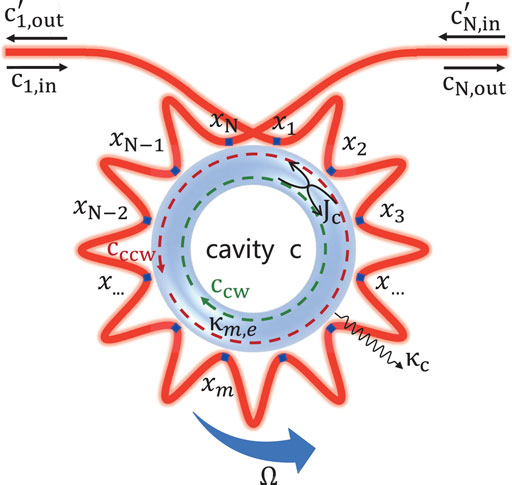
FIGURE 1. (Color online) Schematic of a spinning resonator coupled to a meandering waveguide at multiple coupling points xm with the external loss rate κm,e. The resonator rotates along the CCW direction with an angular speed Ω. The CW and CCW modes of the resonator couple to each other with strength J. The intrinsic decay rate of the resonator is κc.
In our consideration, the Hamiltonian of the spinning resonator can be written as (ℏ = 1)
Here ccw and cccw (
where cm,in and
with
where Γc is the total decay rate of the resonator mode, and κc is the intrinsic decay rate of the resonator.
According to the Heisenberg motional equations, the dynamic equations of the CW and CCW modes are yielded by
Note that kcw = (ωc + ΔF)/c and kccw = (ωc − ΔF)/c are approximately regarded as the central mode vector of right-going and left-going photon in the waveguide emitted by the resonator [23], respectively. Different from the case without rotation, the accumulated phase shifts between neighbor coupling points for opposite propagation directions of the photons are distinct. As given in Refs. [17, 57–59], the local input-output relations for the CW and CCW modes at each coupling point xm are written as
Substituting Eq. 7 into Eq. 6, we obtain the effective dynamic equations
The total input-output relations of this system take the form
Eq. 8 exhibits a self-coupling in the CW or CCW mode, which arises from the self interference effects of reemitted photons between different connection points. Moreover, the Sagnac effect and the self-interference effects may significantly affect the optical properties of the system. We note that only when the resonator is nonspinning, the system is reciprocal. Based on these derivations, we will investigate the photon emission and transport properties in this system.
2.2 Phase Controlled Chiral Emission
In the giant-atom waveguide-QED systems, the multiple coupling points result in a frequency-dependent decay rate and Lamb shift for a giant atom [23, 60]. Similarly, the interference effects induced by multiple coupling points in our system also give a modification of the frequency shift Δj and decay rate Γj for the CW and CCW mode. According to Eq. 8, we have
where
Here we consider the maximally symmetric case, in which decay rates of the resonator modes into the waveguide are the same at each coupling point with κm,e = κe and the distance between neighboring coupling points is identical with xm+1 − xm = d. Then we can set xm − xn = (m − n)d and θj = kjd. Similar to the Lamb shift and decay rate in atomic physics, Eq. 10 becomes
We begin to discuss the effects of the rotation speed and number of coupling points on the emission properties under the condition of κc = 0. When the resonator is nonspinning with Ω = 0, the CW and CCW modes are degenerate with the Fizeau drag ΔF = 0 and ωccw = ωcw = ωc. As increasing the rotation speed Ω, the Sagnac-Fizeau shift described by Eq. 1 linearly increases, as given in Supplementary Material. In our calculations, we choose the related parameters as follows: λ = 1,550 nm, R = 4.73 mm, and n = 1.4. For Ω = 0.97 GHz, we have ΔF/ωc = ±0.05 and (RΩ)/c ≈ 0.015. For the spinning resonator with a single coupling point (N = 1), Eq. 11 gives the results of Δcw = Δccw = 0 and Γcw = Γccw = (κc + κe)/2. When increasing the number of coupling points, the frequency shifts and decay rates for the CW and CCW modes have an opposite shift due to the rotation.
In Figures 2A,B, frequency shifts Δj and decay rates Γj are plotted as a function of the phase θc = ωcd/c with N = 10 and Ω = 0.97 GHz. The frequency shifts Δcw and Δccw take negative and positive values with the maximum at about 0.6Γmax. Given that Δcw (Δccw) is zero, the decay rate Γcw (Γccw) reaches its highest magnitude at θc = 0.95 × 2π (θc = 1.05 × 2π). For θc = 0.95 × 2π, the accumulated phase of photons propagating along the CCW direction leads to Γccw = 0, which arises from the destructive interference effects among the coupling points. In this case, the CCW mode of the resonator is decoupled from the waveguide. Moreover, there are a lot of additional lower and local maximum values in the decay rates. The phase θc of the local minima between these maxima scales with (1/N + ΔF/ωc). Note that the rotation speed and number of coupling points make a big difference in the values of Γcw and Γccw. Narrower resonances can be found in the decay rates when we consider more coupling points.
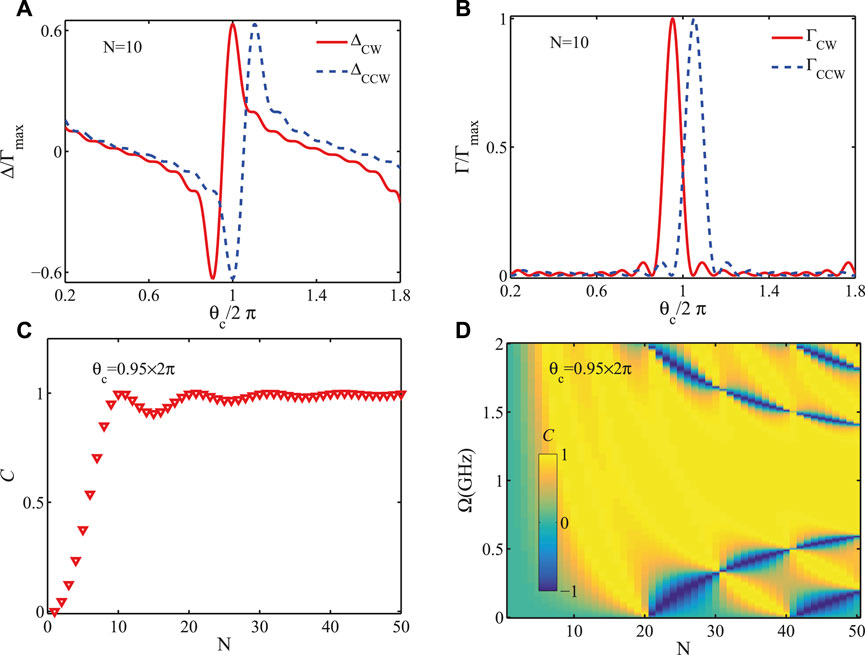
FIGURE 2. (Color online) The frequency shifts Δj (A) and the decay rates Γj (B) for the CW and CCW modes versus phase θc = ωcd/c for N = 10 and Ω = 0.97 GHz. The maximum decay rate Γcw is used for normalization. (C) The chiral factor
In order to study the emission properties more clearly, for a special frequency we define the chirality parameter
where
2.3 Nonreciprocal Photon Transmission
Now we study how the rotation velocity and number of coupling points affect the optical response of the spinning resonator. We consider the resonator is excited by an external input signal in the CW direction with frequency ωl and amplitude ɛ. In this case, the input signal from the left side is given by
Here Δc = ωc − ωl is the detuning between the resonator without rotation and the driving field. The transmission rate of the input signal is given by
Similarly, we also consider the case of an external input signal coming from the right side of the waveguide with
The transmission rate of the input signal is written as
A nonreciprocal photon transmission with TR ≠ TL can be observed when the resonator is spinning. This fact is due to the different numerators in Eqs 13, 15. For the maximally symmetric case, we have
For J = 0, the incident photon will be transmitted and absorbed with reflection being zero. In this scenario, the transmission curve TL represents a Lorentzian line shape centered at Δc = −(ΔF + Δcw) with a linewidth Γcw. For N = 1, we obtain Δc = −ΔF and Γcw = (κc + κe)/2. The transmission dip is around 0. For multiple coupling points, as discussed above, Δcw and Γcw vary periodically with phase θc. The transmission rate TL versus the detuning Δc and the phase θc are plotted in Figure 3A. It shows that θc will dramatically modify the transmission window. As we increase θc, the position of the transmission dip has a red-shift. When the phase θcw is 2π/N, the transmission dip disappears totally with T = 1, which means the resonator cannot be excited by the external field and corresponds to the optical dark state. This phenomenon arises from the destructive interferences in the multiple coupling points, which can be explained by Eq. 17. Moreover, the mode splitting is observed in some parameter range in Figure 3B when J = 5κe. The asymmetry of the two dips results from different decay rates and frequency shifts of these two modes.
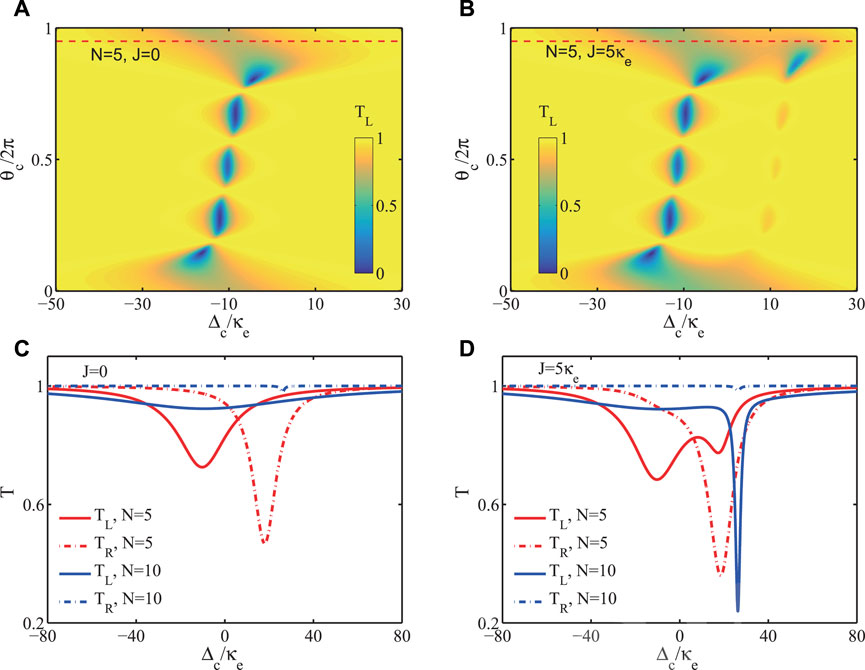
FIGURE 3. (Color online) Transmission rate TR versus detuning Δc/κ and phase θc/2π for different coupling stengths: (A) J = 0, and (B) J = 5κe. Profiles of TR and TL versus Δc/κ with θc = 0.95 × 2π: (C) J = 0 and (D) J = 5κe. Other parameters are set as: κe = 5 × 10−3ωc, Ω = 0.97 GHz, and κc = 2κe.
In Figures 3C,D, we plot the transmission rates TL and TR when the incident photon coming from the left side and right sides versus the detuning Δc for θ = 0.95 × 2π. It shows that TL can be larger or smaller than TR for N = 5. In other words, the nonreciprocal transmission is clearly observed due to the rotation. The interference effects between coupling points enable the transmission dips asymmetric with different linewidths. For N = 10, the decay rate of the CCW mode is very small, which leads to the complete photon transmission with TR = 1. Moreover, a sharp dip appears in the transmission spectra TL for J = 5κe. Note that the phase θc can also be used to adjust the nonreciprocal transmission behavior.
3 Two Spinning Resonators Interacting With Multiple Points
3.1 Hamiltonian and Dynamic Equations
The single-photon transport properties in a one-dimensional waveguide interacted with two giant atoms for three distinct topologies have been discussed in Ref. [61]. To study potential applications of the spinning resonator with multiple coupling points in large-scale quantum chiral networks, we now consider two separate spinning resonators evanescently coupled to a meandering waveguide at several different connection points. As shown in Figure 4, the optical resonator a (b) simultaneously supports both clockwise and counter-clockwise travelling optical modes. The creation operators of the CW and CCW modes are denoted by
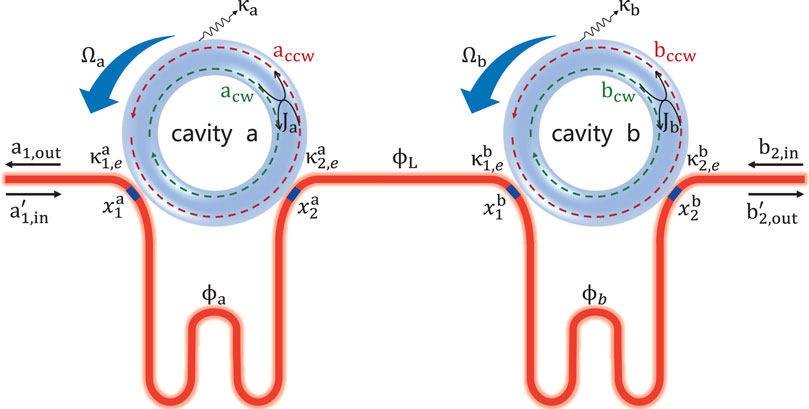
FIGURE 4. (Color online) Schematic of two separate spinning resonators coupled to a meandering waveguide at several coupling points
The Hamiltonian of these two spinning resonators are given by
Here Ja (Jb) is the coupling strength between the CW and CCW modes of the resonator a (b). The CCW (CW) modes in the resonators can only be driven by an optical field coming from the left (right) side of the waveguide. The amplitudes of the input fields at different coupling points are denoted by am,in, bm,in,
The non-Hermitian Hamiltonian of the whole system can be given by
where
The effective dynamic evolution equations of the cavity modes can be written as
where
Note that Fcw (Fccw) denotes the effective unidirectional coupling strength between the CW (CCW) modes of these two resonators. The total input-output relations of this system take the form
By using Eqs 21, 23, we can investigate the photon transport properties of this system in the steady state.
3.2 Nonreciprocal Photon Transmission
In the following, we consider the input signal only comes from one side of the waveguide. Supposed that an external input signal b2,in is injected from the right side of the waveguide with
where
Here, Δa = ωa − ωl (Δb = ωb − ωl) is the detuning between the resonator a (b) without rotation and the driving field. According to Eq. 23, the transmission rate of the output port a1,out for the input signal b2,in can be defined as
Similarly, when an external input signal is injected from the left side of the waveguide with
Once again, the transmission rate of the ouput port
In the following, we choose the related parameters as follows: ωa = ωb = ωc, Ωa = Ωb = 0.97 GHz,
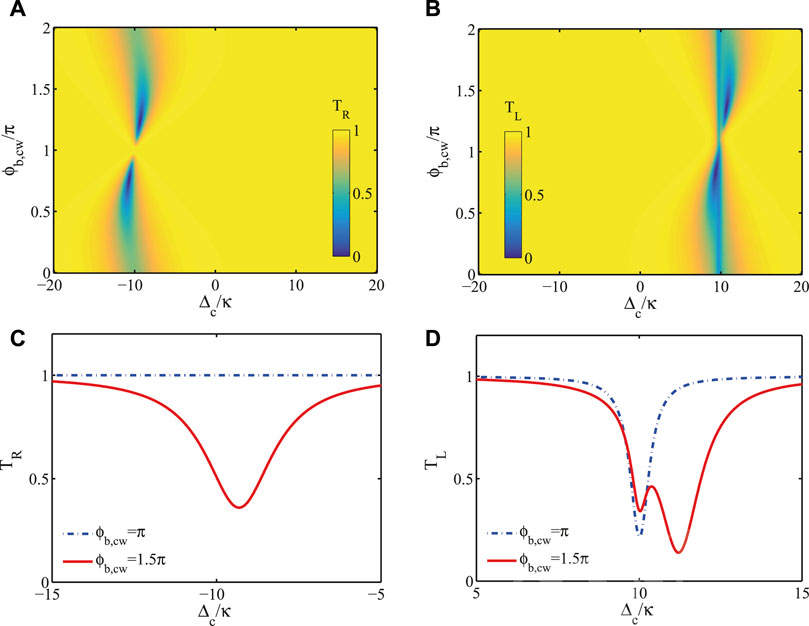
FIGURE 5. (Color online) Transmission rates TR (A) and TL (B) versus the detuning Δc/κ and the phase ϕb,cw/π. The corresponding transmission rates as a function of detuning Δc/κ for different phases ϕb,cw/π are plotted in (C,D). The parameters are set as: κ = 5 × 10−3ωc, Ω = 0.97 GHz,
In Figures 6A,B, we plot the transmission rates TR and TL versus the detuning Δc/κ for different Jb. For Jb = 10κ, the transmission spectra display an asymmetric four-dips structure. When decreasing Jb, the transmission dips can be suppressed. Moreover, TL is always larger (smaller) than TR in the region of Δc < 0 (Δc > 0). In order to describe the nonreciprocity clearly, we define the isolation ratio as
In Figure 7, the isolation ratio
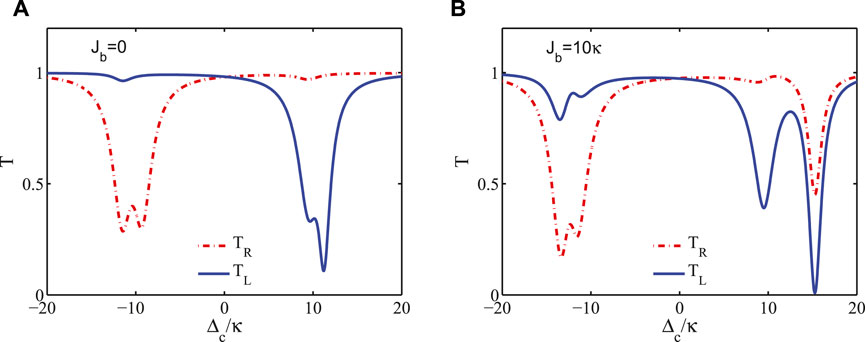
FIGURE 6. (Color online) The transmission rates TR and TL versus the detuning Δc/κ for (A) Jb = 0 and (B) Jb = 10κ. The parameters are set as: κ = 5 × 10−3ωc, Ω = 0.97 GHz,
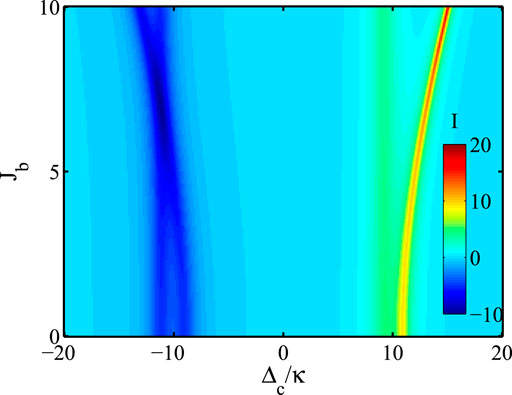
FIGURE 7. (Color online) The isolation ratio
4 Conclusion
In conclusion, we have explored the photon emission and transport properties of spinning resonators coupled to a meandering waveguide at multiple coupling points. We demonstrate that the accumulated phases between multiple coupling points for photons propagating in CW and CCW directions are different. Both “giant-atoms” induced interference effects and mode frequency shifts led by the Sagnac effect dramatically modify photon transport properties. The emission direction and rates can be tuned by changing the spinning speed or number of coupling points. Moreover, the complete photon transmission over the whole optical frequency band led by destructive interference is observed, when photons coming from the right hand of the waveguide. This nonreciprocal phenomenon is very different from that observed in other optical systems. We have also studied the extended two-cavity system. The nonreciprocal photon transmission is controlled by changing the phases among adjacent coupling points or coupling strengths between the CW and CCW modes. By extending our proposal to multiple cavities interacting with multiple points, one can implement a multi-node chiral quantum network. In experiment, such a system with a spinning spherical resonator coupling to a stationary taper has been realized, where the angular speed is about 6.6 kHz [51]. The silica nanoparticle rotating with frequency exceeding 1 GHz has also been reported [62]. Therefore, we believe our theoretical proposals can be realized under current experimental approach. Those results in our paper provide a novel way to engineer rotatable nonreciprocal optical devices, which can be exploited for the realization of large-scale quantum networks and quantum information processing.
Data Availability Statement
The original contributions presented in the study are included in the article/Supplementary Material, further inquiries can be directed to the corresponding author.
Author Contributions
XW contributed to conception. WL performed the numerical simulations and produced the first draft. All authors contributed to manuscript revision, read, and approved the submitted version.
Funding
WL was supported by the Natural Science Foundation of Henan Province (No. 222300420233). XW was supported by the National Natural Science Foundation of China (NSFC) (Nos. 12174303 and 11804270) and the China Postdoctoral Science Foundation (No. 2018M631136).
Conflict of Interest
The authors declare that the research was conducted in the absence of any commercial or financial relationships that could be construed as a potential conflict of interest.
Publisher’s Note
All claims expressed in this article are solely those of the authors and do not necessarily represent those of their affiliated organizations or those of the publisher, the editors, and the reviewers. Any product that may be evaluated in this article, or claim that may be made by its manufacturer, is not guaranteed or endorsed by the publisher.
Supplementary Material
The Supplementary Material for this article can be found online at: https://www.frontiersin.org/articles/10.3389/fphy.2022.894115/full#supplementary-material
Supplementary Figure S1 | The Sagnac-Fizeu shift ΔF as a function of the spinning angular velocity Ω for the CW (red line) and CCW (blue line) mode. Other related parameters are Λ = 1550∼nm, R = 4.73∼nm, and n = 1.4.
References
1. Zheng H, Gauthier DJ, Baranger HU. Waveguide-QED-based Photonic Quantum Computation. Phys Rev Lett (2013) 111:090502. doi:10.1103/PhysRevLett.111.090502
2. Liao Z, Zeng X, Nha H, Zubairy MS. Photon Transport in a One-Dimensional Nanophotonic Waveguide QED System. Phys Scr (2016) 91:063004. doi:10.1088/0031-8949/91/6/063004
3. Roy D, Wilson CM, Firstenberg O. Colloquium : Strongly Interacting Photons in One-Dimensional Continuum. Rev Mod Phys (2017) 89:021001. doi:10.1103/RevModPhys.89.021001
4. Akimov AV, Mukherjee A, Yu CL, Chang DE, Zibrov AS, Hemmer PR, et al. Generation of Single Optical Plasmons in Metallic Nanowires Coupled to Quantum Dots. Nature (2007) 450:402–6. doi:10.1038/nature06230
5. Vetsch E, Reitz D, Sagué G, Schmidt R, Dawkins ST, Rauschenbeutel A. Optical Interface Created by Laser-Cooled Atoms Trapped in the Evanescent Field Surrounding an Optical Nanofiber. Phys Rev Lett (2010) 104:203603. doi:10.1103/PhysRevLett.104.203603
6. Goban A, Hung C-L, Yu S-P, Hood JD, Muniz JA, Lee JH, et al. Atom-light Interactions in Photonic Crystals. Nat Commun (2014) 5:1–9. doi:10.1038/ncomms4808
7. Goban A, Hung C-L, Hood JD, Yu S-P, Muniz JA, Painter O, et al. Superradiance for Atoms Trapped along a Photonic crystal Waveguide. Phys Rev Lett (2015) 115:063601. doi:10.1103/PhysRevLett.115.063601
8. Corzo NV, Gouraud B, Chandra A, Goban A, Sheremet AS, Kupriyanov DV, et al. Large Bragg Reflection from One-Dimensional Chains of Trapped Atoms Near a Nanoscale Waveguide. Phys Rev Lett (2016) 117:133603. doi:10.1103/PhysRevLett.117.133603
9. Astafiev O, Zagoskin AM, Abdumalikov AA, Pashkin YA, Yamamoto T, Inomata K, et al. Resonance Fluorescence of a Single Artificial Atom. Science (2010) 327:840–3. doi:10.1126/science.1181918
10. Van Loo AF, Fedorov A, Lalumière K, Sanders BC, Blais A, Wallraff A. Photon-mediated Interactions between Distant Artificial Atoms. Science (2013) 342:1494–6. doi:10.1126/science.1244324
11. Hoi I-C, Palomaki T, Lindkvist J, Johansson G, Delsing P, Wilson CM. Generation of Nonclassical Microwave States Using an Artificial Atom in 1D Open Space. Phys Rev Lett (2012) 108:263601. doi:10.1103/PhysRevLett.108.263601
12. Shen JT, Fan S. Coherent Photon Transport from Spontaneous Emission in One-Dimensional Waveguides. Opt Lett (2005) 30:2001. doi:10.1364/OL.30.002001
13. Zhou L, Gong ZR, Liu Y-x., Sun CP, Nori F. Controllable Scattering of a Single Photon inside a One-Dimensional Resonator Waveguide. Phys Rev Lett (2008) 101:100501. doi:10.1103/PhysRevLett.101.100501
14. Witthaut D, Sørensen AS. Photon Scattering by a Three-Level Emitter in a One-Dimensional Waveguide. New J Phys (2010) 12:043052. doi:10.1088/1367-2630/12/4/043052
15. Huang J-F, Shi T, Sun CP, Nori F Controlling Single-Photon Transport in Waveguides with Finite Cross Section. Phys Rev A (2013) 88:013836. doi:10.1103/PhysRevA.88.013836
16. Liao Z, Nha H, Zubairy MS. Dynamical Theory of Single-Photon Transport in a One-Dimensional Waveguide Coupled to Identical and Nonidentical Emitters. Phys Rev A (2016) 94:053842. doi:10.1103/PhysRevA.94.053842
17. Xiao Y-F, Li M, Liu Y-C, Li Y, Sun X, Gong Q. Asymmetric Fano Resonance Analysis in Indirectly Coupled Microresonators. Phys Rev A (2010) 82:065804. doi:10.1103/PhysRevA.82.065804
18. Li B-B, Xiao Y-F, Zou C-L, Jiang X-F, Liu Y-C, Sun F-W, et al. Experimental Controlling of Fano Resonance in Indirectly Coupled Whispering-Gallery Microresonators. Appl Phys Lett (2012) 100:021108. doi:10.1063/1.3675571
19. Sinha K, Meystre P, Goldschmidt EA, Fatemi FK, Rolston SL, Solano P. Non-Markovian Collective Emission from Macroscopically Separated Emitters. Phys Rev Lett (2020) 124:043603. doi:10.1103/PhysRevLett.124.043603
20. Yu Y, Ma F, Luo X-Y, Jing B, Sun P-F, Fang R-Z, et al. Entanglement of Two Quantum Memories via Fibres over Dozens of Kilometres. Nature (2020) 578:240–5. doi:10.1038/s41586-020-1976-7
21. Mitsch R, Sayrin C, Albrecht B, Schneeweiss P, Rauschenbeutel A. Quantum State-Controlled Directional Spontaneous Emission of Photons into a Nanophotonic Waveguide. Nat Commun (2014) 5:1–5. doi:10.1038/ncomms6713
22. Le Feber B, Rotenberg N, Kuipers L. Nanophotonic Control of Circular Dipole Emission. Nat Commun (2015) 6:1–6. doi:10.1038/ncomms7695
23. Frisk Kockum A, Delsing P, Johansson G. Designing Frequency-dependent Relaxation Rates and Lamb Shifts for a Giant Artificial Atom. Phys Rev A (2014) 90:013837. doi:10.1103/PhysRevA.90.013837
24. Guo L, Grimsmo A, Kockum AF, Pletyukhov M, Johansson G. Giant Acoustic Atom: a Single Quantum System with a Deterministic Time Delay. Phys Rev A (2017) 95:053821. doi:10.1103/PhysRevA.95.053821
25. Kockum AF, Johansson G, Nori F. Decoherence-free Interaction between Giant Atoms in Waveguide Quantum Electrodynamics. Phys Rev Lett (2018) 120:140404. doi:10.1103/PhysRevLett.120.140404
26. Kannan B, Ruckriegel MJ, Campbell DL, Frisk Kockum A, Braumüller J, Kim DK, et al. Waveguide Quantum Electrodynamics with Superconducting Artificial Giant Atoms. Nature (2020) 583:775–9. doi:10.1038/s41586-020-2529-9
27. Zhao W, Wang Z. Single-photon Scattering and Bound States in an Atom-Waveguide System with Two or Multiple Coupling Points. Phys Rev A (2020) 101:053855. doi:10.1103/PhysRevA.101.053855
28. Frisk Kockum A. Quantum Optics with Giant Atoms-The First Five Years. In: International Symposium on Mathematics, Quantum Theory, and Cryptography. Singapore: Springer (2021). p. 125–46. doi:10.1007/978-981-15-5191-8_12
29. Yu H, Wang Z, Wu J-H. Entanglement Preparation and Nonreciprocal Excitation Evolution in Giant Atoms by Controllable Dissipation and Coupling. Phys Rev A (2021) 104:013720. doi:10.1103/PhysRevA.104.013720
30. Du L, Chen Y-T, Li Y. Nonreciprocal Frequency Conversion with Chiral Λ -type Atoms. Phys Rev Res (2021) 3:043226. doi:10.1103/PhysRevResearch.3.043226
31. Du L, Cai M-R, Wu J-H, Wang Z, Li Y. Single-photon Nonreciprocal Excitation Transfer with Non-markovian Retarded Effects. Phys Rev A (2021) 103:053701. doi:10.1103/PhysRevA.103.053701
32. Wang X, Liu T, Kockum AF, Li H-R, Nori F. Tunable Chiral Bound States with Giant Atoms. Phys Rev Lett (2021) 126:043602. doi:10.1103/PhysRevLett.126.043602
34. Soro A, Kockum AF. Chiral Quantum Optics with Giant Atoms. Phys Rev A (2022) 105:023712. doi:10.1103/PhysRevA.105.023712
35. Du L, Chen YT, Zhang Y, Li Y. Giant Atoms with Time-dependent Couplings (2022). arXiv preprint arXiv:2201.12575.
36. Gustafsson MV, Aref T, Kockum AF, Ekström MK, Johansson G, Delsing P. Propagating Phonons Coupled to an Artificial Atom. Science (2014) 346:207–11. doi:10.1126/science.1257219
37. Manenti R, Kockum AF, Patterson A, Behrle T, Rahamim J, Tancredi G, et al. Circuit Quantum Acoustodynamics with Surface Acoustic Waves. Nat Commun (2017) 8:1–6. doi:10.1038/s41467-017-01063-9
38. Andersson G, Suri B, Guo L, Aref T, Delsing P. Non-exponential Decay of a Giant Artificial Atom. Nat Phys (2019) 15:1123–7. doi:10.1038/s41567-019-0605-6
39. Goto T, Dorofeenko AV, Merzlikin AM, Baryshev AV, Vinogradov AP, Inoue M, et al. Optical Tamm States in One-Dimensional Magnetophotonic Structures. Phys Rev Lett (2008) 101:113902. doi:10.1103/PhysRevLett.101.113902
40. Khanikaev AB, Mousavi SH, Shvets G, Kivshar YS. One-way Extraordinary Optical Transmission and Nonreciprocal Spoof Plasmons. Phys Rev Lett (2010) 105:126804. doi:10.1103/PhysRevLett.105.126804
41. Fan L, Wang J, Varghese LT, Shen H, Niu B, Xuan Y, et al. An All-Silicon Passive Optical Diode. Science (2012) 335:447–50. doi:10.1126/science.1214383
42. Cao Q-T, Wang H, Dong C-H, Jing H, Liu R-S, Chen X, et al. Experimental Demonstration of Spontaneous Chirality in a Nonlinear Microresonator. Phys Rev Lett (2017) 118:033901. doi:10.1103/PhysRevLett.118.033901
43. Lira H, Yu Z, Fan S, Lipson M. Electrically Driven Nonreciprocity Induced by Interband Photonic Transition on a Silicon Chip. Phys Rev Lett (2012) 109:033901. doi:10.1103/PhysRevLett.109.033901
44. Estep NA, Sounas DL, Soric J, Alù A. Magnetic-free Non-reciprocity and Isolation Based on Parametrically Modulated Coupled-Resonator Loops. Nat Phys (2014) 10:923–7. doi:10.1038/nphys3134
45. Sounas DL, Alù A. Non-reciprocal Photonics Based on Time Modulation. Nat Photon (2017) 11:774–83. doi:10.1038/s41566-017-0051-x
46. Lu X, Cao W, Yi W, Shen H, Xiao Y. Nonreciprocity and Quantum Correlations of Light Transport in Hot Atoms via Reservoir Engineering. Phys Rev Lett (2021) 126:223603. doi:10.1103/PhysRevLett.126.223603
47. Jing H, Lü H, Özdemir SK, Carmon T, Nori F. Nanoparticle Sensing with a Spinning Resonator. Optica (2018) 5:1424–30. doi:10.1364/OPTICA.5.001424
48. Li B, Huang R, Xu X, Miranowicz A, Jing H. Nonreciprocal Unconventional Photon Blockade in a Spinning Optomechanical System. Photon Res (2019) 7:630–41. doi:10.1364/PRJ.7.000630
49. Huang R, Miranowicz A, Liao J-Q, Nori F, Jing H. Nonreciprocal Photon Blockade. Phys Rev Lett (2018) 121:153601. doi:10.1103/PhysRevLett.121.153601
50. Jiao Y-F, Zhang S-D, Zhang Y-L, Miranowicz A, Kuang L-M, Jing H. Nonreciprocal Optomechanical Entanglement against Backscattering Losses. Phys Rev Lett (2020) 125:143605. doi:10.1103/PhysRevLett.125.143605
51. Maayani S, Dahan R, Kligerman Y, Moses E, Hassan AU, Jing H, et al. Flying Couplers above Spinning Resonators Generate Irreversible Refraction. Nature (2018) 558:569–72. doi:10.1038/s41586-018-0245-5
52. Fang Y-LL, Baranger HU Waveguide QED: Power Spectra and Correlations of Two Photons Scattered off Multiple Distant Qubits and a Mirror. Phys Rev A (2015) 91:053845. doi:10.1103/PhysRevA.91.053845
53. Zhu J, Özdemir SK, Xiao Y-F, Li L, He L, Chen D-R, et al. On-chip Single Nanoparticle Detection and Sizing by Mode Splitting in an Ultrahigh-Q Microresonator. Nat Photon (2010) 4:46–9. doi:10.1038/nphoton.2009.237
54. Özdemir ŞK, Zhu J, Yang X, Peng B, Yilmaz H, He L, et al. Highly Sensitive Detection of Nanoparticles with a Self-Referenced and Self-Heterodyned Whispering-Gallery Raman Microlaser. Proc Natl Acad Sci U.S.A (2014) 111:E3836–E3844. doi:10.1073/pnas.1408283111
55. Malykin GB. The Sagnac Effect: Correct and Incorrect Explanations. Phys.-Usp. (2000) 43:1229–52. doi:10.1070/pu2000v043n12abeh000830
57. Xiao Y-F, Gaddam V, Yang L. Coupled Optical Microcavities: an Enhanced Refractometric Sensing Configuration. Opt Express (2008) 16:12538–43. doi:10.1364/OE.16.012538
58. Xu S, Fan S. Fano Interference in Two-Photon Transport. Phys Rev A (2016) 94:043826. doi:10.1103/PhysRevA.94.043826
59. Du L, Wang Z, Li Y. Controllable Optical Response and Tunable Sensing Based on Self Interference in Waveguide QED Systems. Opt Express (2021) 29:3038–54. doi:10.1364/OE.412996
60. Cai QY, Jia WZ. Coherent Single-Photon Scattering Spectra for a Giant-Atom Waveguide-QED System beyond the Dipole Approximation. Phys Rev A (2021) 104:033710. doi:10.1103/PhysRevA.104.033710
61. Feng SL, Jia WZ. Manipulating Single-Photon Transport in a Waveguide-QED Structure Containing Two Giant Atoms. Phys Rev A (2021) 104:063712. doi:10.1103/PhysRevA.104.063712
Keywords: chiral emission, nonreciporal transmission, quantum interference, spinning cavity, waveguide-QED
Citation: Liu W, Lin Y, Li J and Wang X (2022) Nonreciprocal Waveguide-QED for Spinning Cavities with Multiple Coupling Points. Front. Phys. 10:894115. doi: 10.3389/fphy.2022.894115
Received: 11 March 2022; Accepted: 25 March 2022;
Published: 25 April 2022.
Edited by:
Zhihai Wang, Northeast Normal University, ChinaReviewed by:
Yan Zhang, Northeast Normal University, ChinaWenzhi Jia, Southwest Jiaotong University, China
Copyright © 2022 Liu, Lin, Li and Wang. This is an open-access article distributed under the terms of the Creative Commons Attribution License (CC BY). The use, distribution or reproduction in other forums is permitted, provided the original author(s) and the copyright owner(s) are credited and that the original publication in this journal is cited, in accordance with accepted academic practice. No use, distribution or reproduction is permitted which does not comply with these terms.
*Correspondence: Xin Wang, d2FuZ3hpbi5waHlAeGp0dS5lZHUuY24=
 Wenxiao Liu
Wenxiao Liu Yafen Lin
Yafen Lin Jiaqi Li2
Jiaqi Li2 Xin Wang
Xin Wang